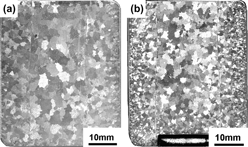Crossref Citations
This article has been cited by the following publications. This list is generated based on data provided by
Crossref.
Wang, Jing
Fu, Junwei
Dong, Xuguang
and
Yang, Yuansheng
2012.
Microstructure and mechanical properties of as-cast Mg–Al–Sn–Y–Nd alloy.
Materials & Design (1980-2015),
Vol. 36,
Issue. ,
p.
432.
WANG, Jing
LIU, Ruidong
DONG, Xuguang
and
YANG, Yuansheng
2013.
Microstructure and mechanical properties of Mg-Zn-Y-Nd-Zr alloys.
Journal of Rare Earths,
Vol. 31,
Issue. 6,
p.
616.
Yin, Jian
Ma, Xiu Jun
Yao, Jun Ping
and
Zhou, Zhi Jian
2014.
Effects of Pulsed Magnetic Field on the Microstructure and Mechanical Properties of Mg<sub>97</sub>Y<sub>2</sub>Zn<sub>1</sub> Alloy.
Advanced Materials Research,
Vol. 1004-1005,
Issue. ,
p.
123.
LUO, Tian-jiao
JI, Huan-ming
CUI, Jie
ZHAO, Fu-ze
FENG, Xiao-hui
LI, Ying-ju
and
YANG, Yuan-sheng
2015.
As-cast structure and tensile properties of AZ80 magnesium alloy DC cast with low-voltage pulsed magnetic field.
Transactions of Nonferrous Metals Society of China,
Vol. 25,
Issue. 7,
p.
2165.
Ji, H. M.
Luo, T. J.
Wang, C.
Cui, J.
and
Yang, Y. S.
2017.
Direct chill casting of magnesium alloy under pulsed magnetic field.
Materials Science and Technology,
Vol. 33,
Issue. 1,
p.
33.
Tong, Xin
You, Guoqiang
Wang, Yichang
Wu, Hong
Liu, Weili
Li, Peiqi
and
Guo, Wei
2018.
Effect of ultrasonic treatment on segregation and mechanical properties of as-cast Mg–Gd binary alloys.
Materials Science and Engineering: A,
Vol. 731,
Issue. ,
p.
44.
Chen, Qi Peng
Oguma, Hidetaka
and
Shen, Hou Fa
2019.
Numerical Simulation of Electromagnetic Phenomena and Solidification under a Pulsed Magnetic Field.
Materials Science Forum,
Vol. 944,
Issue. ,
p.
52.
Ranjan, Rishitosh
Surekha, B.
and
Ghose, Prakash
2021.
Effect of Cooling Slope Process Parameters on Non-dendritic Feedstock Production: A Comprehensive Review.
Journal of The Institution of Engineers (India): Series C,
Vol. 102,
Issue. 3,
p.
821.
Tong, Ying
Zhang, Yu-Qing
Zhao, Jiang
Quan, Guo-Zheng
and
Xiong, Wei
2021.
Wear-Resistance Improvement of 65Mn Low-Alloy Steel through Adjusting Grain Refinement by Cyclic Heat Treatment.
Materials,
Vol. 14,
Issue. 24,
p.
7636.
Yang, Xin
Zhang, Liguo
Cao, Dong
Han, Xiao
Zhang, Yuanyuan
and
He, Zhijun
2022.
Influence of Pulse Current on Inclusion Properties of Alumina in Molten Steel.
Metals,
Vol. 12,
Issue. 10,
p.
1742.
Chen, Yaobang
Zhou, Jianzhong
Li, Pengfei
Huo, Kun
and
Meng, Xiankai
2022.
Effect of Electromagnetic Field on Wear Resistance of Fe901/Al2O3 Metal Matrix Composite Coating Prepared by Laser Cladding.
Materials,
Vol. 15,
Issue. 4,
p.
1531.
Mao, Hongkui
Bai, Xiaoyu
Wang, Yu
He, Yang
Zhao, Zhanyong
Xu, Hong
Hou, Jibo
Wang, Yanlong
and
Chen, Lihua
2022.
Solidified behavior and microstructure of high strength Al–Mg alloy under electromagnetic field simulated by direct current.
Journal of Materials Research,
Vol. 37,
Issue. 5,
p.
1115.
Song, Jiaxin
He, Dongyu
Guo, Weiling
Huang, Yanfei
Li, Zhixiong
Wang, Haidou
and
Xing, Zhiguo
2023.
Effect of Magnetic Field Type on the Flight State of Supersonic Plasma Spray Particles and Coating Properties.
Journal of Thermal Spray Technology,
Vol. 32,
Issue. 6,
p.
1637.
Zhu, Xiao-ping
Yao, Jun-qing
Wu, Hai-long
Liu, Xin-wang
Liu, Hua
Fan, Zi-tian
Lü, Shu-lin
Wang, Kai
and
Wang, Zi-dong
2023.
Microstructure and mechanical properties of a cast heat-resistant rare-earth magnesium alloy.
China Foundry,
Vol. 20,
Issue. 4,
p.
289.
Lin, C.J.
Peng, L.
Xian, J.W.
Li, Q.
and
Gourlay, C.M.
2023.
Eutectic solidification in Mg-9Al-0.7Zn: From divorced to coupled growth.
Journal of Alloys and Compounds,
Vol. 938,
Issue. ,
p.
168571.





